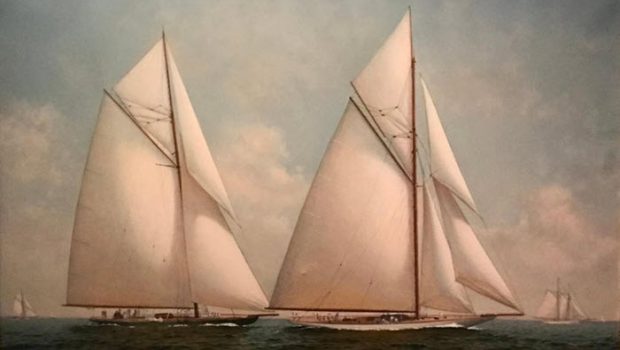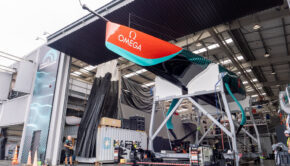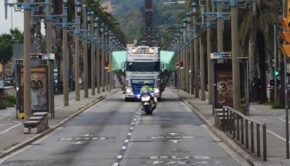America’s Cup: Looking back 100 years
Published on August 30th, 2020
The America’s Cup stirs up plenty of commentary, and we found in the archives this report from 100 years ago by Mme. Futura Imperfect in which she shared strong feelings about the 13th edition. Held in 1920 under the Universal Rule of measurement, the match was between the 106-foot defender Resolute and the 110-foot Shamrock IV, the fourth in Sir Thomas Lipton’s line of Cup challengers. Enjoy…
(August 31, 1920) – As a resident of New York and an enthusiast of the nautical arts, I watched this summer’s International Yacht Races for the America’s Cup with great interest but found only disappointment. This wretched spectacle is an utter disgrace to the sport of yacht racing and far too removed from the everyday experiences of working seamen.
In the first place, the yachts can hardly even be called such—rather, they are overly-fragile technological toys to which most sailors cannot even relate. As we all witnessed this past July, the New York Yacht Club had to call off several of the races because of “high winds” of a mere 23 knots, a blow at which most of those of us who have experienced the open Atlantic can only chortle.
If the “Shamrock” and the “Resolute” are truly the greatest triumphs of the boatbuilder’s art in the 20th century, then surely it is a badge of shame that they cannot race under such conditions. Seventy years ago, was not the “America” herself sturdy enough to voyage from Sandy Hook to Cowes all on her own? The men of the NYYC ought to be ashamed for having fallen so far from the example of their grandfathers.
The “Resolute” is certainly beautiful, but as a purpose-built racer one can scarcely imagine it will have much of an afterlife now that its purpose is accomplished— and what of the “Shamrock” in defeat? Mister Herreshoff has been called a wizard, but such a frivolous bit of technical gimmickry as the “Resolute” seems more in line with the various flashy apparatus of illusionists on stage— perhaps his next yacht will be for Mister Houdini.
I am also appalled by the prevalence of advertising and crass corporate sponsorship in the modern Cup. Mister Lipton’s campaign upon the “Shamrock” sometimes seemed less like a sincere attempt to win the Cup than an excuse for an American whistle-stop tour promoting his tea.
Although Lipton certainly seems a pleasant gentleman in person, surely such a savvy fellow must realize that attempting to sell tea to Americans is a fool’s endeavor. We Yanks have been partial to coffee ever since Mr. Lipton’s countrymen attempted to tax us for drinking tea, and we voiced our displeasure in Boston Harbor.
To assert, as the Irishman does, that by the 21st century New York will have tea shops on every corner sounds like the ravings of a man utterly star-struck and star-bucked.
Furthermore, I am greatly disconcerted by the rumors that the NYYC are contemplating a change of venue for the next International Yacht Races. Although many of their members are known for their summer cottages in Newport, to decamp to that venue after decades of racing off New York, would be a most deplorable break with tradition.
How could they ever hope to attract in Rhode Island the audience the Races have found in New York? For what is an obscure and minuscule state best known as of late for producing the lunatic scribblings of Mister Lovecraft, a move for the America’s Cup to Newport? Heaven forbid!
Perhaps the men of the NYYC should study their insignia and remind themselves of the first two words of their organization’s name, lest they be tempted to host the next competition, after Newport, upon the shores of the south of Spain or in the most remote Antipodes.
The one bright spot in the Defense of 1920, in my mind, has been the integration of the new broadcast technology.
Our forefathers were content to watch in person off Manhattan or if not in New York, to wait for dispatches by telegraph or the evening newspapers. These are still, in my opinion as a yachtswoman, the most enjoyable experiences for a spectator of the International Yacht Races, but in the past few decades more and more attention has been given to the marvels of the radio.
This past summer the Races were fully covered by the radio-newsmen of Old Gotham, bringing live coverage of every tack into the homes of every family in America with the proper equipment. Thousands of young people all across our nation were able to shut their eyes and listen, becoming virtual spectators of the contest as if they were truly there among us in New York.
I can think of no better medium by which to promote the sport to the youth of the modern Electric Age.
My brother-in-law in Halifax tells me that the news stories of the postponed races were considered great comic literature among the fishermen of the Grand Banks, Yankee and Canadian alike— “Yacht race cancelled on account of wind, ha! ha!”
There are proposals afoot in the Great White North for a new race intended only for working fishing craft, as a demonstration of the true skill and hardiness of the working sailor, and in this regard I can wish the Bluenosers nothing but good luck. Certainly such a race would be a better exemplar of our sport than last month’s debacle off Sandy Hook.
There is, I believe, a relevant expression in the French — “Plus ça change, plus c’est la même chose.”
Editor’s note: Okay, this is satire, submitted by Kai Yves about the last America’s Cup edition in New York before the competition moved in 1930 to Newport, RI. However, 100 years later, she views many of the issues from 1920 remain today, closing with the French quote, “plus ça change, plus c’est la meme chose” which translated means the more things change, the more they stay the same.









 We’ll keep your information safe.
We’ll keep your information safe.